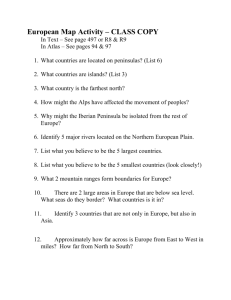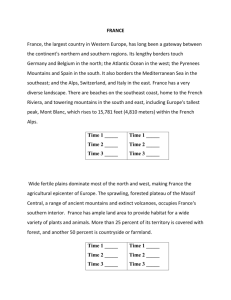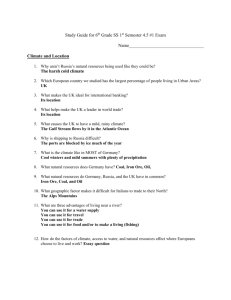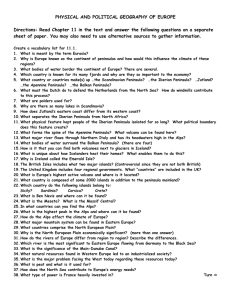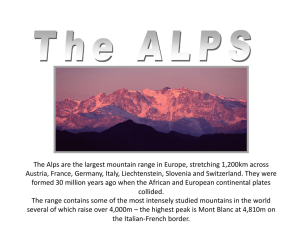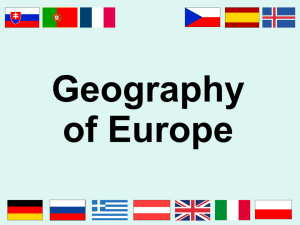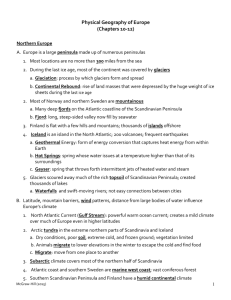THE PHYSICAL GEOGRAPHY of EUROPE
advertisement
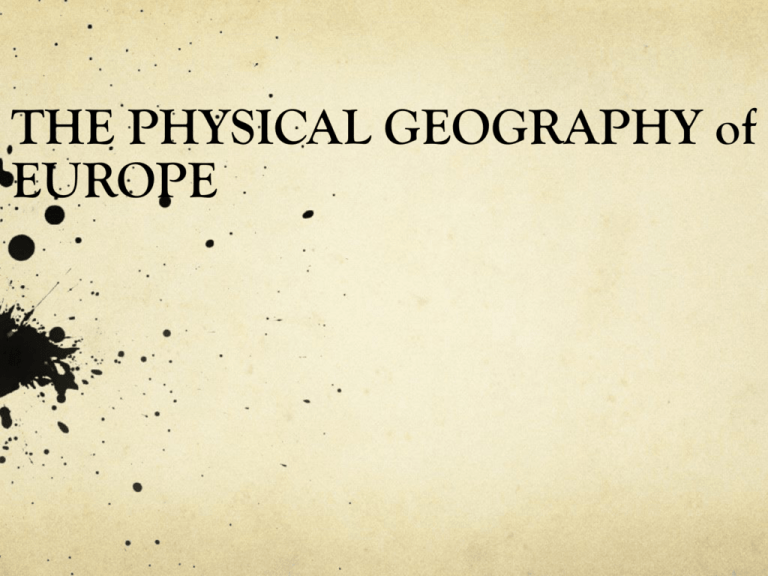
THE PHYSICAL GEOGRAPHY of EUROPE What makes it a Region? Located in the Northern Hemisphere Generally mild climate Many languages and cultures Dreadful common past (wars, famines, etc) Powerful and emerging economies The Land Key Terms: Glaciation Loess Dike Polder Fjord Places of Interest Alps North Sea Rhine River Mediterranean Sea Po River Northern European Plain Baltic Sea British Isles Aegean Sea Danube River Black Sea The Land: Main Idea Europe’s Landscape has shaped the lives and settlement patterns of Europeans Northwestern mountains rounded by erosion and glaciation (how glaciers form and spread) Ex: Ben Nevis- highest peak in British Isles Central Uplands (Iberian Peninsula to Eastern Europe) Meseta- Spain Massif Central- France Southern Europe (Jagged mountains) Pyrenees and Alps Alps- S. France to Balkan Peninsula Mont Blanc- Highest peak in Alps (15, 771 ft) Po and Rhine head waters in the Alps Southern Europe (cont) Carpathian Mountains Eastern Europe- from Slovakia to Romania Northern European Plain Fertile = farming 1800s- discovery of mineral deposits Paris, and Berlin located there Other point of interest Great Hungarian Plain The Alps Seas, Peninsula’s and Islands Most of Europe is about 300 miles from the sea coast Good and bad Netherlands 25 % of it is under sea level Forced to build dikes to hold back water Polder- land between dikes Europe’s Peninsula’s Northern Peninsula- largest Scandinavian PeninsulaCaused by glaciation Fjords- steep sided inlets Southern Peninsula Main feature = Mediterranean Sea Europe’s Islands Iceland Volcanoes, hot springs, and geysers Hot springs provide natural heating for homes British Isles Great Britain, Ireland, and many small islands Rocky cliffs; steep bays Mediterranean Sea Sicily, Corsica, Sardinia, Crete, Cyprus Water Systems Rivers flow from the mountains to the coast Used for transport, irrigation, and hydroelectric power Different regions, different systems Scandinavian Peninsula = short and not connected Iberian Peninsula = narrow and shallow England (Thames) = ships can reach the Port of London Rhine Most Important in Western Europe Swiss Alps to France, Germany, and the Netherlands Connects industrial cities to the Port of Rotterdam in the Black Sea Water Systems (cont) Danube Links southern Germany to Hungary and Romania Natural Resources Influence economic activity in Europe Iron and coal led to the modernization of Europe Coal, Iron, Oil, Natural Gas, Nuclear and Hydroelectric power France, Sweden, Ukraine – Iron Ore Rhine River The Danube Climate and Vegetation Key Terms: Permafrost, timberline, mistral, sirocco, foehn, avalanche Main Idea Latitude, mountain barriers, wind patterns, and distance from large bodies of water influence Europe’s climate Vary from cold and barren to warm and shrub covered Western and Southern Climate Maritime winds shape it North Atlantic Current – leads to mild climate Eastern and Northern Colder because of distant from the Atlantic Ocean Climate Regions Cold in the North to dry steppe in the South Wind, ocean currents, latitude, and landforms, all shape Europe’s climates High – Latitudes Cold winter; short summer Tundra regions = have permafrost Subarctic = coniferous EXCEPTION Western Norway, Iceland, and Sweden Warmer because they are on the water 90 inches of rainfall annually, because of the Norwegian, and North Atlantic Currents Midlatitudes Marine West Coast Mild winters, cool summers, abundant rainfall Shaped by the Gulfstream and North Atlantic Currents Deciduous (leaves fall in Winter) and coniferous trees Southern Europe Mediterranean Climate Hot, dry Summer; mild rainy Winter Other forces Mistral – strong wind from Northern Alps; bitterly cold winds Siroccos – dry winds blowing in from Africa; heat wave Eastern Europe Humid – continental Cold, snowy winters; hot summers Alps Highland Climate Foehns- winter winds that cause avalanches Dry Regions Parts of S.E. and S.W. Europe Dry steppe climate Dry cold grassland from Hungary, Serbia, Montenegro, and Romania Hot Summer; Extreme Winter Meseta 81,000 sq. mi Madrid is at its center Meseta
